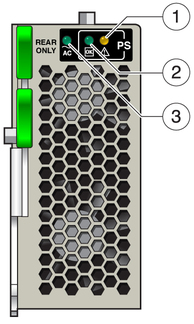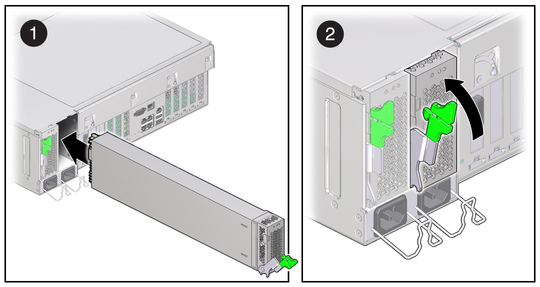| Skip Navigation Links | |
| Exit Print View | |

|
Sun Fire X4470 Server Service Manual |
1. Sun Fire X4470 Server Service Manual Overview
1.1.1 Intel Xeon 7500 Platform
1.1.7 Summary of Supported Components and Capabilities
1.2 Server Front Panel Features
1.3 Server Back Panel Features
1.4 Performing Service Related Tasks
2. Preparing to Service the Sun Fire X4470 Server
2.1 Location of Replaceable Components
2.2 Tools and Equipment Needed
2.3 Performing Electrostatic Discharge and Static Prevention Measures
2.3.1 Using an Antistatic Wrist Strap
2.4 Positioning the Server for Maintenance
Extend the Server to the Maintenance Position
2.5 Releasing the Cable Management Arm
Power Off the Server Using the Service Processor Command-Line Interface
2.7 Removing the Server Top Cover
2.8 Removing or Installing Filler Panels
2.9 Attaching Devices to the Server
3. Servicing CRU Components That Do Not Require Server Power Off
3.1 Servicing Disk Drives (CRU)
3.1.1 Disk Drive Status LED Reference
3.1.2 Removing and Installing Disk Drives and Disk Drive Filler Panels
Remove a Disk Drive Filler Panel
Install a Disk Drive Filler Panel
3.2 Servicing Fan Modules (CRU)
3.2.2 Fan Module LED Reference
3.2.3 Detecting Fan Module Failure
3.2.4 Removing and Installing Fan Modules
3.3 Servicing Power Supplies (CRU)
3.3.1 Power Supply LED Reference
3.3.2 Detecting a Power Supply Failure
4. Servicing CRU Components That Require Server Power Off
4.1 Servicing Memory Risers and DIMMs (CRU)
4.1.1 CPUs, Memory Risers, and DIMMs Physical Layout
4.1.2 Memory Riser Population Rules
4.1.3 Memory Riser DIMM Population Rules
4.1.4 Memory Performance Guidelines
4.1.7 Removing and Installing Memory Risers, DIMMs, and Filler Panels
Remove a Memory Riser Filler Panel
Remove a Memory Riser and DIMM
Install Memory Risers and DIMMs
Install a Memory Riser Filler Panel
4.2 Servicing PCIe Cards (CRU)
4.2.1 PCIe Card Configuration Rules
4.2.2 PCIe Cards With Bootable Devices
4.2.3 Avoiding PCI Resource Exhaustion Errors
4.2.4 Removing and Installing PCIe Cards and PCIe Card Filler Panels
Remove a PCIe Card Filler Panel
Install a PCIe Card Filler Panel
4.3 Servicing the DVD Drive and DVD Driver Filler Panel (CRU)
Remove the DVD Drive or DVD Drive Filler Panel
Install the DVD Drive or DVD Drive Filler Panel
4.4 Servicing the System Lithium Battery (CRU)
5.1 Servicing the CPU and Heatsink (FRU)
5.1.2 Removing and Installing a Heatsink Filler Panel, CPU Cover Plate, Heatsink, and CPU
5.2 Servicing the Fan Board (FRU)
5.3 Servicing the Power Supply Backplane (FRU)
Remove the Power Supply Backplane
Install the Power Supply Backplane
5.4 Servicing the Disk Drive Backplane (FRU)
Remove the Disk Drive Backplane
Install the Disk Drive Backplane
5.5 Servicing the Motherboard (FRU)
6. Returning the Server to Operation
6.1 Replacing the Server Top Cover
6.2 Returning the Server to the Normal Rack Position
Return the Server to the Normal Rack Position
7. Servicing the Server at Boot Time
7.3 Default BIOS Power-On Self-Test (POST) Events
7.4 BIOS POST F1 and F2 Errors
7.5 How BIOS POST Memory Testing Works
7.6 Ethernet Port Device and Driver Naming
7.6.1 Ethernet Port Booting Priority
7.8 Performing Common BIOS Procedures
7.8.1 Configuring Serial Port Sharing
8. Troubleshooting the Server and Oracle ILOM Defaults
8.1 Troubleshooting the Server
8.2.1 Diagnostic Tool Documentation
8.3 Using the Preboot Menu Utility
8.3.1 Accessing the Preboot Menu
8.3.2 Restoring Oracle ILOM to Default Settings
8.3.3 Restoring Oracle ILOM Access to the Serial Console
8.3.4 Restoring the SP Firmware Image
8.3.5 Preboot Menu Command Summary
8.5 Locating the Chassis Serial Number
A.3 Environmental Requirements
B.2 BIOS Advanced Menu Selections
B.3 BIOS PCIPnP Menu Selections
B.5 BIOS Security Menu Selections
B.6 BIOS I/O MMIO Menu Selections
B.7 BIOS Chipset Menu Selections
C.3 Gigabit-Ethernet Connectors
C.4 Network Management Port Connector
The power supplies on the Sun Fire X4470 Server are redundant. That is, the server needs only one power supply to operate. Redundant power supplies enable you to remove and replace a power supply without shutting down the server, provided that the other power supply is online and working.
The server offers two redundancy modes for the power supplies. Light load efficiency mode (LLEM) places PS1 in a warm standby condition while PS0 carries the entire load more efficiently by itself. If PS0 loses AC power or is extracted for replacement, PS1 takes over the load automatically. Some rare internal failures of PS0 could cause the server to lose power faster than PS1 can take over.Disabling the LLEM Policy causes the power supplies to share the load at all times, at the expense of efficiency during light loads. For information about configuring policies, refer to the Oracle Integrated Lights Out Manager (ILOM) 3.0 Supplement for Sun Fire X4470 Server (821-0702).
 | Dikkat - If a power supply fails and you do not have a replacement available, to ensure proper airflow, leave the failed power supply installed in the server until you replace it with a new power supply. |
This section describes how to remove and install power supplies.
Each power supply contains a series of LEDs on the back panel of the system as shown in Power Supply Status LEDs .
Figure 3-7 Power Supply Status LEDs

Power Supply Status LED Descriptions describes the functions of the LEDs.
Table 3-3 Power Supply Status LED Descriptions
|
The following LEDs are lit when a power supply fault is detected:
Front and rear Service Action Required LEDs
Rear PS Fault LED on the front bezel of the server
Service Action Required LED on the faulty power supply
See 1.2 Server Front Panel Features and 1.3 Server Back Panel Features for locations of system LEDs.
Use the following procedures to remove and install power supplies.
 | Caution - Hazardous voltages are present. To reduce the risk of electric shock and danger to personal health, follow the instructions. |
Refer to Removing a Power Supply when completing the following procedure.
See 2.3 Performing Electrostatic Discharge and Static Prevention Measures.
A lit Service Action Required LED on a power supply indicates that a failure was detected.
 | Caution - Whenever you remove a power supply, you should replace it with another power supply; otherwise, the server might overheat due to improper airflow. If a new power supply is not available, leave the failed power supply installed until it can be replaced. |
Figure 3-8 Removing a Power Supply

Refer to Installing a Power Supply when completing this procedure.
 | Caution - Install an A239A or A239C power supply, labeled for upright installation, in the Sun Fire X4470 Server. The A239A/A239C power supply correctly exhausts air from the rear of the server. Do not install an A239 or A239B power supply, which might cause the system to overheat and shut down. |
Figure 3-9 Installing a Power Supply

Service Action Required LED on the power supply
Front and rear Service Action Required LEDs
Rear PS Failure LED on the bezel of the server
See 1.2 Server Front Panel Features and 1.3 Server Back Panel Features for locations of system LEDs.